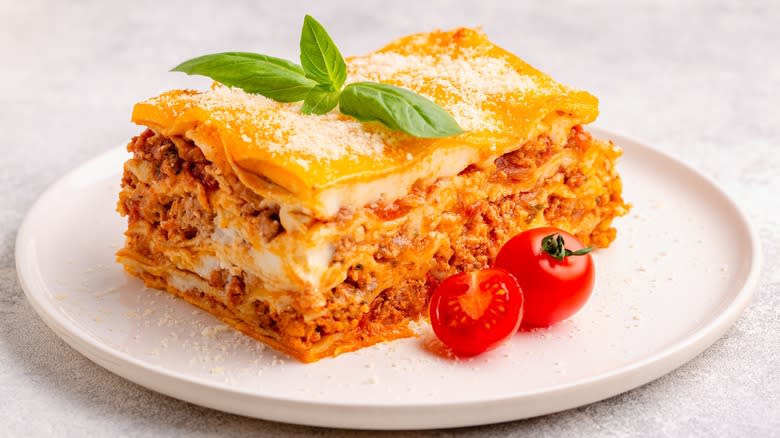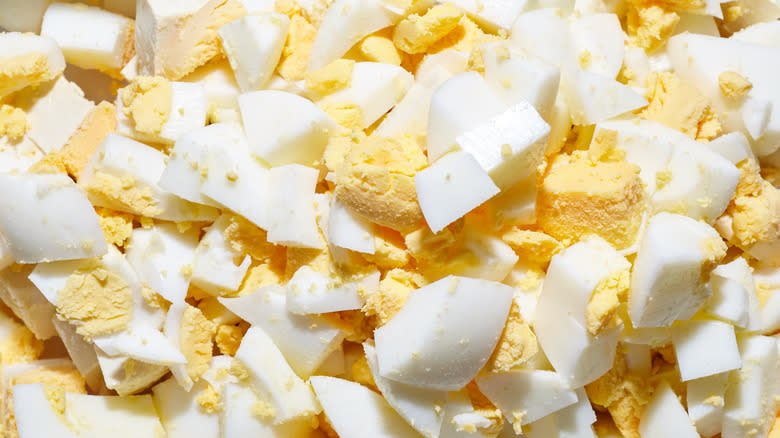Hard-Boiled Eggs Are An Unexpected Ingredient For The Best Lasagna

A long time ago, during the 13th century, the first recipes for lasagna emerged. These early lasagnas were tomato- and meat-free, containing layers of artichokes, eggplant, spinach, pasta, and cheeses. Food globalization introduced tomatoes to Italy in the 16th century, and meat was added when lasagna traveled outside of Italy. From its humble, yet delicious origins, the recipe for a classic lasagna transformed into the iconic pasta dish it is today. There are unexpected yet remarkably harmonious additions you can make within that popular combination of ingredients, such as hard-boiled eggs.
Whether minced, sliced, or crumbled, hard-boiled egg pieces can be scattered or layered with wide noodles, rich meaty ragu, and a smooth ricotta cheese or béchamel sauce. The pieces of the hard-boiled egg will add a creamy, rich disposition to the dish's other components, effortlessly blending between the levels of sauce and pasta. When sliced, their firm yet tender texture helps you build thicker layers, perfect if you use a deep pasta dish or want your lasagna to have more pronounced tiers. Hard-boiled eggs are a common ingredient in lasagnas throughout southern Italy. Once you try hard-boiled eggs in your lasagna, you'll agree, as they say in Italian, it's che buono (so good).
Read more: 14 Liquids To Add To Scrambled Eggs (And What They Do)
What Does The Prized Boiled Egg Bring?

Hard-boiled eggs are used in innumerable dishes, from adding bulk to light salads to injecting richness to a sandwich filling, or even as a garnish in dishes such as ramen. In a lasagna, the hard-boiled eggs can take on either a leading role or a more subtle support. The flavor profile of a hard-boiled egg is mildly savory, with the yolk imparting a rich, buttery aroma and texture. Incorporating thickly sliced boiled eggs creates a more dominating presence in lasagna, both visually and in distinct egg flavors. Crumbled or minced egg pieces can take on a more nuanced role, mildly mingling between the saucy levels.
Whichever way you use hard-boiled eggs in your lasagna, it's important to boil them in salted water. Egg whites solidify quicker in salty, hot water than unsalted, which can be a lifesaver if the egg cracks during the boiling process. If you wish to produce a sliced egg layer, place the boiled eggs into an ice bath for at least 5 minutes immediately after cooking. This will simplify the peeling process significantly and enable you to keep the eggs' oval shape intact.
This All Started In Sicily

On the southern Italian island of Sicily, it's common to find hard-boiled eggs added to lasagna; and in Naples, this addition is regarded as essential for a particular festivity. In Naples, lasagne di Carnevale, a culinary symbol of indulgence during the carnival season, is a dish to be lavishly devoured before the period of Lent begins.
Between the sheets of pasta and red sauce, lasagne di Carnevale features an abundance of glorious ingredients. Small juicy meatballs made from veal and pork on top of the lasagna, delicious browned pork ribs in the ragu, rich salami and cubed caciocavallo scattered between pasta sheets, and a stunning layer of hard-boiled egg slices come together to produce a lasagna that represents culinary extravagance at its finest. If you happen to be in Naples during Carnivale, and especially on Fat Tuesday, you'll have no difficulty finding this divine version of lasagna.
If you want to give your lasagna the extra luxuriant touch of a perfect hard-boiled egg, draw inspiration from Italian traditions and the vibrant city of Naples: Add hard-boiled eggs to your lasagna's layers for a rich, creamy, and downright delightful surprise.
Read the original article on Daily Meal.

